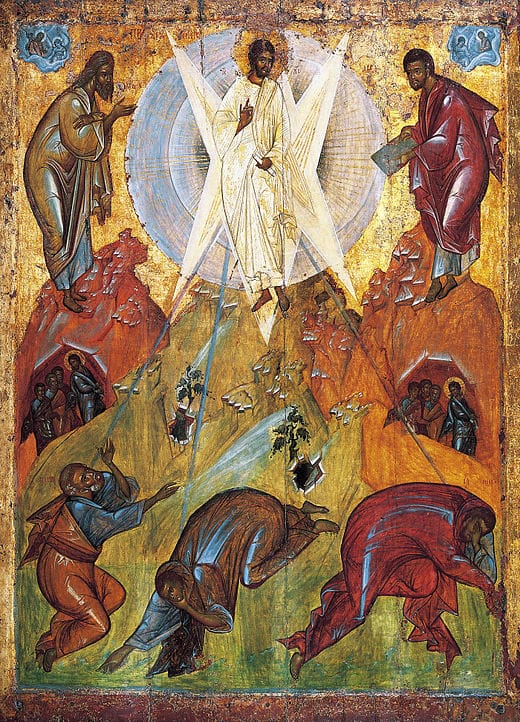Both the Catholic and the Orthodox Churches celebrate the feast of the Transfiguration of Christ on August 6. It is a well-known episode c of the Life of Jesus. He went up to Mount Tabor with the disciples Peter, James and John, and changed his appearance showing himself to the three in an extraordinary light, thus revealing his divinity.
From the common experience of severe stillness under umbrellas and the intense light of the sun in this period we are invited today to meditate on the taboric light, when everything was enveloped in a joyful and theandric light.
The real test of every iconographer according to tradition is precisely the icon of this solemnity. The Byzantine icon of the Transfiguration according to the oriental vision gives meaning to all iconic writing; in fact, as the scholar Florenskij affirms, “at the foundation of the icon there is an experience of light, and the task of the icon is to reflect the light of the Tabor”. The whole icon of the Transfiguration is light, there is no shadow; however, the light is not produced by the usual light sources, but by the dazzling presence of Christ.
The secret revealed to the three apostles Peter, James and John on Mount Tabor is the secret that every beautiful icon must communicate. In the light of faith in Jesus Christ, reality undergoes a metamorphosis: the believer perceives that vocation to the light which is already beginning to permeate creation. Divine Beauty, for which our heart has deep nostalgia and intense need, is given to the disciples on today’s feast.
I point out two interpretations of the Transfiguration in patristic theology.
Saint Irenaeus of Lyons, inserts the theme of unknowability in the literature on the Transfiguration, with the formula “Deus in carne absconditus”, showing that precisely through the revelation of his glory, Jesus hides the face of the Father at the exact moment in which he show. Deus Absconditus refers to free will. Divinity manifests itself in a way that does not violate man’s freedom, that faith remains a choice, not an obvious and irrefutable fact for reason.
There would therefore be a deliberate weakening of the revelatory character in the Transfiguration.
Here is inserted the other interpretation of the opposite sign on the charism of “spiritual vision.” According to this conception, the disciples chosen by Jesus did not contemplate the Taboric light with their bodily eyes, but with a super-sensitive gaze, commensurate with their spiritual strength. Theology of Maximus the Confessor this idea is transformed into the doctrine on the mystical illumination of the Christian. From here on, it was observed, there is the basic material for the subsequent Hesychastic vision of the Transfiguration: the teaching of the revealing energies of God distinct from His essence, the mystical and purifying effect of these energies in the believing soul, and its possibility of seeing God in the uncreated light.
A Calabrian also enters the theological debate around the form of Christian meditation practiced throughout the Christian East called Hesychasm.
Around the year 1337, Hesychasm attracted the attention of Barlaam of Seminara, a Calabrian monk transferred to Constantinople. Barlaam met the Hesychasts and listened to descriptions of their practices. Trained in Western Scholastic theology, Barlaam was shocked by the descriptions he heard and wrote several treatises against it. He called the doctrine of uncreated light heretical according to which the goal of Hesychast practice is the experience of light seen by the disciples during the Transfiguration of Christ on Mount Tabor. The Hesychasts claimed that this light did not belong to the divine essence, but it was something else. Barlaam held this polytheistic concept, as he postulated two eternal beings, one visible (immanent) and one invisible (transcendent) God.
The monk of Mount Athos Gregory Palamas defended Hesychasm from Barlaam’s attacks in a series of synods in Constantinople, wrote a series of works in support of him, and was finally recognized as a saint by the Orthodox Church.
While more and more people today are looking for transcendental meditation methods by turning to other spirituality traditions such as Indian or Tibetan ones, this extraordinary method of meditation exists in the heart of Byzantine Christianity. Hesychasm is a form of repeated prayer or experiential prayer which, since the 13th century at the latest, has taken the form of a particular psychosomatic technique combined with heart prayer. It consists in focusing the mind on God in incessant prayer. “Hesychast”, writes San Giovanni Climacco “is he who tries to circumscribe the incorporeal in the body. The cell of the hexicast is the very limits of his body: inside there is a dwelling of wisdom ”.
Dazzled by the brilliance of the “material” sun, in August we contemplate the disciples in the presence of the divine spiritual Light: we can look for it in prayer but also immediately contemplate in the mirror all sparkling with the light of the icons.
Icon of the Transfiguration (1403, attributed to Theophanes the Greek)

